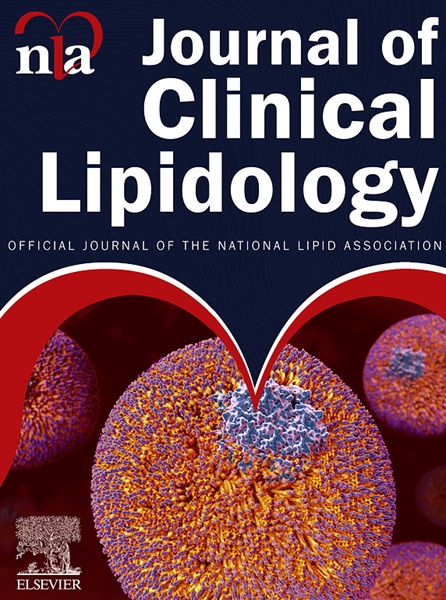Lipoprotein subfractions and carotid plaque: NMR analysis of triglyceride-rich vs LDL particle size concentrations (ELSA-Brasil study)
IF 3.6
3区 医学
Q2 PHARMACOLOGY & PHARMACY
引用次数: 0
Abstract
BACKGROUND
This study analyzed the cross-sectional association of elevated concentrations of low-density lipoprotein particles (LDLp) and triglyceride-rich lipoprotein particles (TRLp) with carotid artery plaque (CAP) in the ELSA-Brasil cohort.
METHODS
Data from 3801 participants (median age: 50.0 years [IQR 44.0-57.0], 54.3% women) with no prior history of cardiovascular disease nor use of lipid-lowering medications were analyzed. CAP was assessed by ultrasonography, while nuclear magnetic resonance (NMR) spectroscopy was used to measure LDLp and TRLp concentrations according to size. Poisson regression models characterized the association of elevated lipid concentrations (≥1 SD above the mean) with CAP, adjusted for sociodemographic variables, cardiovascular risk factors, and for the concentration of high-density lipoprotein particles (HDLp), LDLp, and TRLp.
RESULTS
The frequency of CAP was 33.9% (n = 1,287). Elevated concentrations of total TRLp (prevalence ratio [PR]:1.05 [95% CI:1.01-1.10]) and small-sized TRLp (PR:1.23 [95% CI:1.11-1.36]) were associated with CAP, but lost significance after adjustment for LDLp. Elevated LDLp concentration was associated with CAP in total (PR:1.10 [95% CI:1.05-1.15]) and in all the different sizes (large [PR:1.09], medium [PR:1.11] and small [PR:1.09]), regardless of TRLp. When both LDLp and TRLp were simultaneously included in a dedicated model, only LDLp remained associated with CAP (PR:1.11 [95% CI: 1.06-1.16]). By particle size, elevated small TRLp and elevated LDLp in all sizes were associated with CAP even when mutually adjusted.
CONCLUSION
The elevated concentration of small TRLp seems to portend an incremental residual likelihood of prevalent CAP beyond LDLp, whereas the association of LDLp with CAP remained consistent beyond classical risk factors and NMR-assessed HDLp and TRLp concentration.
脂蛋白亚组分和颈动脉斑块:富甘油三酯与低密度脂蛋白粒径浓度的核磁共振分析(elsa -巴西研究)。
研究背景本研究分析了 ELSA-Brasil 队列中低密度脂蛋白颗粒(LDLp)和富含甘油三酯的脂蛋白颗粒(TRLp)浓度升高与颈动脉斑块(CAP)的横断面关联:分析了 3801 名参与者(中位年龄:50.0 岁[四分位距为 44.0-57.0],54.3% 为女性)的数据,这些参与者既无心血管疾病史,也未使用降脂药物。CAP通过超声波检查进行评估,而核磁共振(NMR)光谱则根据大小测量LDLp和TRLp的浓度。泊松回归模型描述了血脂浓度升高(高于平均值≥1 SD)与CAP的关系,并对社会人口学变量、心血管风险因素以及高密度脂蛋白颗粒(HDLp)、低密度脂蛋白和TRLp的浓度进行了调整:CAP发生率为33.9%(n = 1 287)。总 TRLp(患病率比 [PR]:1.05 [95% CI:1.01-1.10])和小尺寸 TRLp(患病率比 [PR]:1.23 [95% CI:1.11-1.36])浓度升高与 CAP 相关,但在对 LDLp 进行调整后,其显著性降低。无论 TRLp 大小如何,低密度脂蛋白浓度升高均与 CAP 相关(PR:1.10 [95% CI:1.05-1.15]),且与所有不同大小(大 TRLp [PR:1.09]、中 TRLp [PR:1.11] 和小 TRLp [PR:1.09])的 CAP 相关。当低密度脂蛋白和TRLp同时被纳入一个专用模型时,只有低密度脂蛋白仍与CAP相关(PR:1.11 [95% CI:1.06-1.16])。根据颗粒大小,即使相互调整,小 TRLp 和所有大小的 LDLp 的升高都与 CAP 相关:结论:小 TRLp 浓度的升高似乎预示着除 LDLp 外,流行性 CAP 的剩余可能性会增加,而除传统的风险因素和 NMR 评估的 HDLp 和 TRLp 浓度外,LDLp 与 CAP 的关系仍然一致。
本文章由计算机程序翻译,如有差异,请以英文原文为准。
求助全文
约1分钟内获得全文
求助全文
来源期刊
CiteScore
7.00
自引率
6.80%
发文量
209
审稿时长
49 days
期刊介绍:
Because the scope of clinical lipidology is broad, the topics addressed by the Journal are equally diverse. Typical articles explore lipidology as it is practiced in the treatment setting, recent developments in pharmacological research, reports of treatment and trials, case studies, the impact of lifestyle modification, and similar academic material of interest to the practitioner.
Sections of Journal of clinical lipidology will address pioneering studies and the clinicians who conduct them, case studies, ethical standards and conduct, professional guidance such as ATP and NCEP, editorial commentary, letters from readers, National Lipid Association (NLA) news and upcoming event information, as well as abstracts from the NLA annual scientific sessions and the scientific forums held by its chapters, when appropriate.

 求助内容:
求助内容: 应助结果提醒方式:
应助结果提醒方式:


